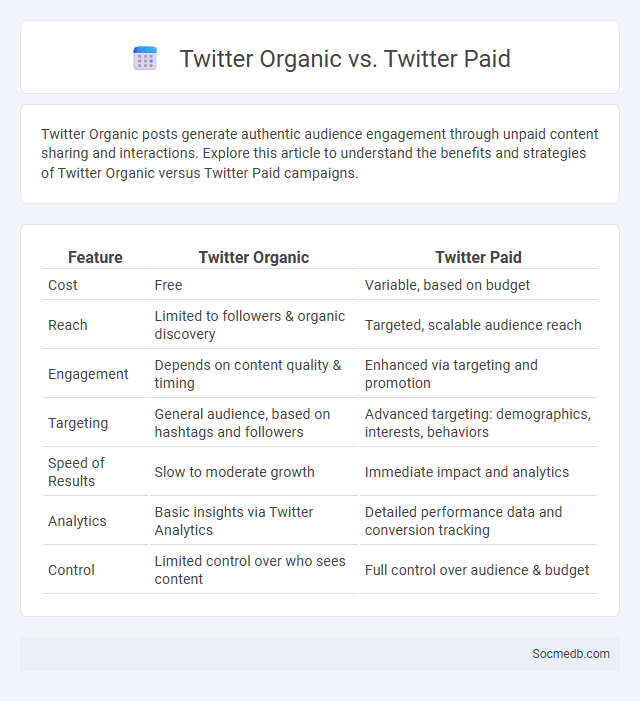
Photo illustration: Twitter Organic vs Twitter Paid
Twitter Organic posts generate authentic audience engagement through unpaid content sharing and interactions. Explore this article to understand the benefits and strategies of Twitter Organic versus Twitter Paid campaigns.
Table of Comparison
| Feature | Twitter Organic | Twitter Paid |
|---|---|---|
| Cost | Free | Variable, based on budget |
| Reach | Limited to followers & organic discovery | Targeted, scalable audience reach |
| Engagement | Depends on content quality & timing | Enhanced via targeting and promotion |
| Targeting | General audience, based on hashtags and followers | Advanced targeting: demographics, interests, behaviors |
| Speed of Results | Slow to moderate growth | Immediate impact and analytics |
| Analytics | Basic insights via Twitter Analytics | Detailed performance data and conversion tracking |
| Control | Limited control over who sees content | Full control over audience & budget |
Understanding Twitter Organic Reach
Twitter organic reach depends on the quality and relevance of your content combined with strategic use of hashtags, mentions, and timing. Your audience engagement, including likes, retweets, and replies, directly influences the visibility of your tweets within their networks. Analyzing Twitter Analytics helps you tailor your posts to maximize organic impressions and connect effectively with your followers.
What is Twitter Paid Promotion?
Twitter Paid Promotion refers to the advertising service on Twitter that allows businesses and individuals to boost their tweets, accounts, or trends to reach a larger, targeted audience beyond their organic followers. Your promoted content appears in users' timelines, search results, or profile pages, increasing visibility, engagement, and conversions through precise demographic, interest, and behavior targeting. This paid strategy optimizes brand awareness, drives traffic, and maximizes ROI on the Twitter platform.
Defining Twitter Ad Campaigns
Twitter ad campaigns target specific audiences using demographic, interest, and behavioral data to maximize engagement and conversion rates. You can customize ads based on objectives like brand awareness, website traffic, or follower growth, enhancing your marketing strategy's precision. Effective campaign management involves continuous monitoring and optimization to improve ROI and drive meaningful social interactions.
Key Differences: Organic vs Paid vs Ad Campaigns
Organic social media growth relies on creating engaging content that attracts genuine followers over time without direct costs, while paid social media uses targeted ads to reach specific demographics quickly. Ad campaigns combine strategic planning, budget allocation, and performance tracking to maximize return on investment (ROI) and achieve precise marketing goals. Understanding these key differences helps you optimize your social media strategy for both long-term engagement and immediate impact.
Benefits of Twitter Organic Strategy
Twitter organic strategy fosters authentic engagement by building genuine connections with followers, enhancing brand trust and loyalty. It drives targeted traffic without hefty advertising costs, leveraging consistent, relevant content to increase visibility and reach. Real-time interaction on Twitter also boosts customer feedback and market insights, enabling agile brand responsiveness and growth.
Advantages of Twitter Paid Promotion
Twitter paid promotion offers precise audience targeting, enabling your brand to reach specific demographics, interests, and locations effectively. You can amplify your content visibility and engagement rates, boosting brand awareness and driving website traffic. Enhanced analytics tools provide valuable insights to optimize campaign performance and maximize return on investment.
When to Use Twitter Ad Campaigns
Twitter ad campaigns are most effective during product launches, time-sensitive promotions, or real-time event engagement to maximize audience reach and interaction. Leveraging Twitter's targeting options, such as keyword and follower targeting, helps brands connect with niche communities and trending conversations. Campaigns run during major industry events or trending hashtags can significantly boost brand visibility and drive immediate traffic.
Cost Comparison: Organic vs Paid on Twitter
Organic social media growth on Twitter relies on consistent content creation and audience engagement, requiring minimal financial investment but significant time commitment. Paid Twitter advertising offers targeted reach with precise demographic filters, enabling faster follower growth and higher visibility, but involves a clear monetary cost that varies by campaign size and objectives. You can maximize your Twitter strategy by balancing organic efforts with paid promotions based on your budget and marketing goals.
Measuring Success: Metrics for Each Approach
Tracking engagement rate, click-through rate (CTR), and follower growth provides a clear measure of success across social media platforms. You should analyze conversion rates and audience demographics to refine your content strategy effectively. Monitoring share of voice and sentiment analysis offers insights into brand perception and competitive positioning.
Choosing the Right Strategy for Your Brand
Selecting the right social media strategy requires understanding your brand's goals, target audience, and unique value proposition. Tailor content formats and posting schedules to engage your followers effectively while monitoring analytics to refine your approach. Your brand's success depends on aligning strategy with audience behavior and platform strengths.
 socmedb.com
socmedb.com